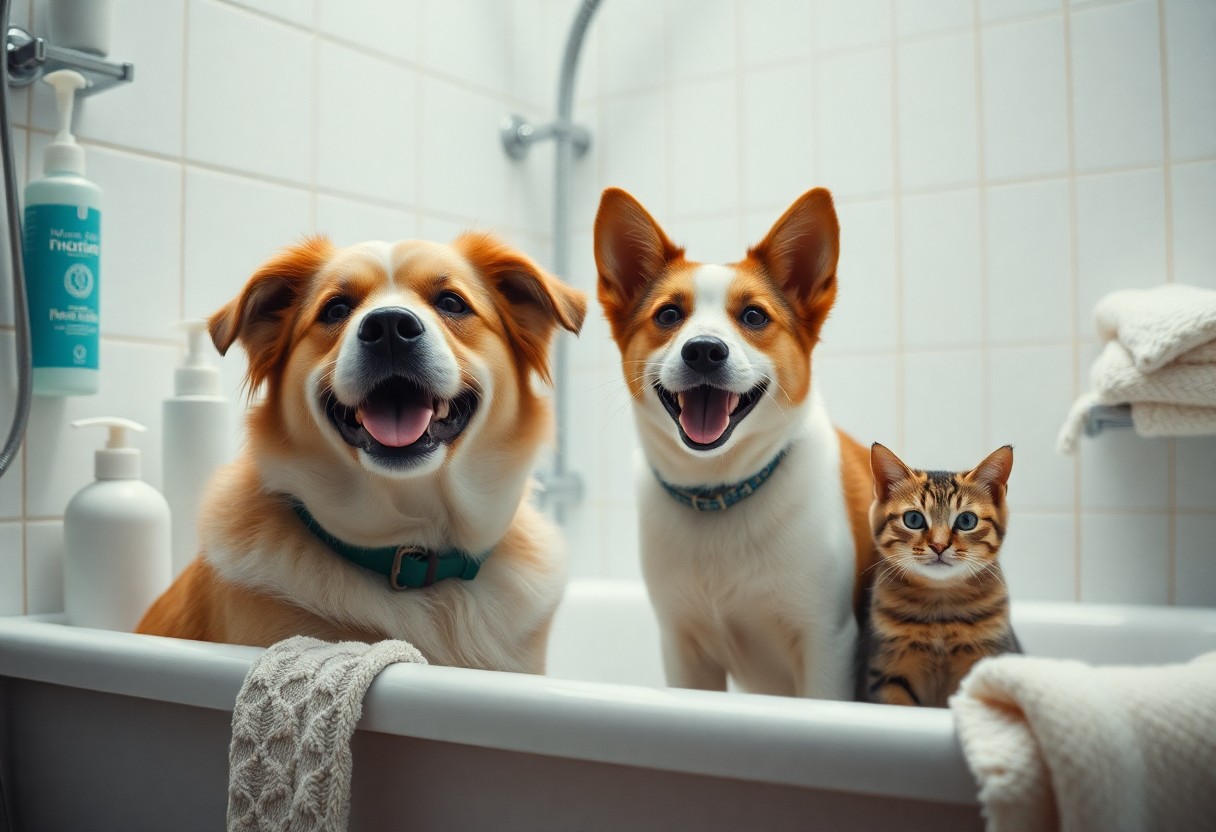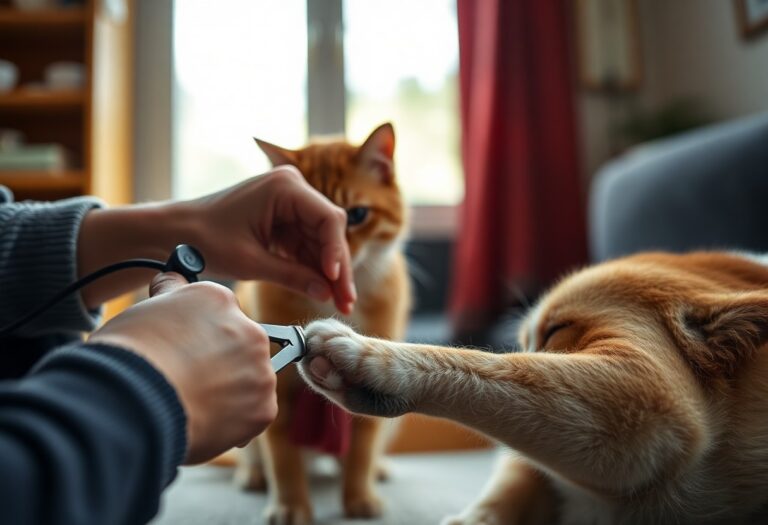You may wonder how often you should bathe your pet to keep them healthy and happy. Bathing frequency can vary based on factors such as your pet’s breed, coat type, and lifestyle. For instance, dogs with oily coats may need more frequent baths, while cats often groom themselves effectively. Over-bathing can strip natural oils and lead to skin problems, so finding the right balance is important. This guide will help you determine the ideal bathing routine for your furry friend, ensuring they stay clean without compromising their skin health.
The Veterinary Perspective: When Bathing is Beneficial
Skin and Coat Health
Your pet’s skin and coat serve as the first line of defense against the environment, and keeping it in optimal condition is paramount. Regular bathing can help remove external irritants like dirt, allergens, and excess oils that can lead to various dermatological issues. For instance, dogs and cats with long or thick coats may experience matting and tangles if not bathed regularly, leading to skin infections. According to veterinarians, using a breed-appropriate shampoo is vital; such products ensure that the natural oils in your pet’s coat are not stripped away. A suggested frequency might be monthly for dogs, depending on activity level, while cats often require less frequent baths due to their grooming habits.
Parasite Management
Bathing also plays a significant role in preventing and managing parasites such as fleas, ticks, and mites. Many flea and tick shampoos contain active ingredients that kill these pests upon contact, reducing the risk of infestation in your home. Regular baths, particularly during warmer months when these parasites are most active, can act as a barrier against infestations. Baths can also aid in the treatment of skin infections that may arise from bites or skin irritations accompanying these pests. For pets exhibiting signs of severe infestation, bathing with veterinary-recommended products can provide both immediate relief and a complementary measure to other treatments.
Veterinarians frequently recommend a comprehensive approach to parasite management that includes bathing alongside monthly prevention treatments such as topical or oral medications. This dual strategy not only addresses current infestations but also helps fortify your pet’s defenses against future attacks. Tracking your pet’s bathing schedule and observing their skin condition after bathing can provide additional insights into their health and the effectiveness of the remedies you choose.
Breed-Specific Bathing Needs: Tailoring Your Approach
Variations in Coat Type
Your pet’s coat type significantly influences how often you should bathe them. Breeds with long, thick fur, such as Golden Retrievers or Afghan Hounds, may require more frequent baths to prevent mats and tangles. The oils from their skin can build up and leave the coat looking dull, thus regular cleaning can help maintain a vibrant appearance. In contrast, smooth-coated breeds like Beagles and Boxers often have a short, sleek coat that may require fewer baths since they naturally shed dirt and debris more easily. A simple wipe down with a damp cloth can often suffice between baths for these breeds.
Behavior and Activity Level Considerations
A pet’s activity level and behavior can also influence your bathing routine. If your dog or cat is energetic and loves to play outside, they may need baths more frequently to remove dirt, mud, and odor. For instance, an energetic Labrador Retriever after a day at the park might warrant a wash to keep their coat clean and smelling fresh. In contrast, less active breeds might not accumulate dirt as quickly, so your bathing schedule can be more relaxed.
Understanding your pet’s individual personality can further guide your bathing habits. If your dog dislikes water, bathing may become a stressful event for both of you. Finding ways to make bath time enjoyable, such as using gentle, pet-specific shampoos and offering treats for good behavior, can help ease the process. On the other hand, a dog that loves water might enjoy more frequent baths. Tailoring your approach to fit your pet’s lifestyle will not only make bath time more manageable but also enhance the overall experience for both of you.
Seasonal Impact: Adapting Bathing Frequency
Winter Dryness vs. Summer Humidity
In the winter months, you might notice that the air is drier, leading to potential dryness and irritation for your pet’s skin. Frequent bathing during this season can strip vital oils from their coat, which could result in higher chances of developing dandruff or dry patches. A good rule of thumb is to limit baths to once every four to six weeks, with the addition of moisturizing products specifically designed for pets to maintain skin hydration and protect against flare-ups. You may also want to consider alternative methods, such as using pet wipes to clean your furry companion between baths.
Conversely, summer brings heat and humidity, which can lead to excessive dirt, sweat, and even pests like fleas or ticks. During this time, increasing bath frequency to about once every two to three weeks might be beneficial for your pet. This helps to remove allergens and dirt from their coat and mitigate any odor issues. Pay attention, however, to the specific needs of your pet—long-haired breeds may require more regular grooming in this weather, while short-haired breeds might need fewer baths.
Outdoor Activities and Environmental Factors
Your pet’s bathing frequency can vary dramatically depending on how often they engage in outdoor play and activities. If your dog loves to romp through muddy puddles or your cat frequently explores the great outdoors, you might need to amp up their bathing schedule to keep their coat tidy and healthy. Outdoor exposure often brings dirt, pollen, and even harmful substances into your pet’s fur, which can lead to skin irritations and infections if not appropriately managed. Regular inspections and baths after substantial outdoor time can help you keep their skin and coat in top condition.
Environmental factors like exposure to allergens or toxins should also influence how you handle your pet’s bathing routine. For instance, pets that frequently interact with grass, dust, or plants may have increased incidences of allergies. Bathing your pet after significant outdoor activities helps remove any irritants clinging to their coat. Tailor your pet’s grooming practices to reflect their lifestyle, as those more inclined to outdoor adventures will require more attention to their bathing habits. Thou shalt adjust the bathing frequency based on the adventures of your pet.
- Outdoor activities can significantly influence your pet’s bathing needs.
- Frequent exposure to mud, pollen, and fleas increases the likelihood of skin issues.
- Monitor your pet closely after outdoor excursions for any irritants that may warrant a bath.
- Adjusting the bathing schedule to fit your pet’s lifestyle ensures health and cleanliness.
- Thou should remain attentive to how your pet interacts with their environment.
Age and Health Considerations: Special Needs for Different Stages
Puppies and Kittens: First Experiences
Your puppies and kittens are experiencing the world and their first bath can be both a bonding experience and a time to get them accustomed to grooming. For many young pets, early exposure to bathing helps to reduce anxiety around water later in life. Start with a gentle, warm bath using a mild, pet-safe shampoo specially formulated for their sensitive skin. Bathing every 3 to 4 weeks is generally sufficient for this age group, especially since they tend to get dirty during their enthusiastic playtime. Always supervise the process, ensuring that your pet feels safe and secure throughout the bath.
Senior Pets: Gentle Care Guidelines
The bathing routine for senior pets requires a more tailored approach as they often face unique health challenges. They may experience reduced mobility, skin sensitivities, or other chronic conditions that warrant a gentle touch. Bathing every 4 to 8 weeks is typically adequate, depending on their individual needs and lifestyle. Using a non-slip mat in the bathing area helps provide stability for your older companion, as senior pets are more prone to slips and falls.
Pay attention to the water temperature as older pets can be more sensitive to heat and cold. Using lukewarm water and being gentle to avoid stressing their joints is imperative. Opt for hypoallergenic and moisturizing shampoos that cater specifically to sensitive skin. After bathing, ensure that you dry their coats thoroughly, especially for breeds prone to skin conditions. It’s also wise to keep an eye on any changes in skin or coat health during this time, as they can signal deeper issues requiring attention.
In addition to these considerations, keep in mind that bathing can sometimes be an overwhelming experience for senior pets, especially if they have never enjoyed it before. Establishing a calming routine can minimize stress; perhaps introducing some relaxation spot before the bath, along with soft music, can make the process less daunting. Make an effort to do this gradually, allowing your pet to acclimate at their own pace, further ensuring that the bath remains a positive experience throughout their golden years.
Practical Bathing Tips for Pet Owners
Gearing up for bath time can be a breeze if you have a plan in place. Start by gathering everything you need beforehand, including towels, shampoo, and a non-slip mat to ensure your pet feels secure during the bathing process. Make sure the bathing area is comfortable; a warm space will help keep your pet relaxed. Always use warm water, as cold water can be uncomfortable and cause your pet to become startled. Create a pleasant atmosphere by speaking soothingly and using a calm demeanor throughout the process. You want to establish a positive association with bath time rather than a stressful ordeal.
- Gather supplies before starting.
- Use warm, not hot or cold water.
- Consider a non-slip mat for safety.
- Speak soothingly to calm your pet.
- Give treats after bathing to create positive reinforcement.
Assume that your dog loves spending time outdoors; you may find that they need baths more frequently, especially after romping through muddy areas or bodies of water.
Selecting the Right Products
Your choice of pet shampoo can significantly impact your pet’s comfort and coat health. Selecting a pet-friendly shampoo is important—opt for products specifically designed for your pet’s species and coat type. Ingredients to look out for include natural oils and moisturizing elements that hydrate the coat without stripping away natural oils. Additionally, avoid shampoos with harsh chemicals or fragrances that can irritate your pet’s skin. In cases of allergies or skin conditions, consult your veterinarian for recommendations on specialized shampoos.
If your pet has specific needs, such as a sensitive stomach or allergic reactions, focus on hypoallergenic options. Conduct a patch test before applying any new product to your pet fully. Apply a small amount on a hidden area of their skin and observe for any adverse reaction. This tip ensures that their bath time remains enjoyable rather than a cause of discomfort.
Techniques for Stress-Free Bathing
The key to a smooth bathing experience lies in preparation and approach. Ensure that your pet has had ample exercise before bath time, as tired pets are generally more relaxed. Bathing in a calm environment without distractions can make a significant difference. With the right techniques, like gently wetting your pet from the neck down with a handheld showerhead or cup, you can ease them into the process. Always avoid spraying water directly on their face, as this can lead to panic or resistance.
Utilizing treats during the bath can bolster their positive association with the experience. You might want to try using a lick mat smeared with peanut butter or a favorite pasty treat; this keeps their focus away from the bath while giving them something to enjoy. Keeping bath time consistent in duration and frequency will also help to desensitize your pet, making them more accustomed and relaxed during each bathing session.
As you refine your bathing techniques, you will likely notice improvements in your pet’s overall demeanor towards baths, making the experience much smoother for both you and your furry friend.
Final Words
Presently, the frequency of bathing your pet largely depends on its breed, lifestyle, and skin condition. As a general guideline, dogs may need a bath every one to three months, while cats are less prone to require frequent baths due to their self-grooming habits. However, if your dog enjoys outdoor activities or has a particularly oily coat, more frequent baths might be necessary. Keep an eye on your pet’s coat and skin—if you notice odor or dirt buildup, it might be time for a wash, regardless of the schedule you’ve set. Always opt for pet-specific shampoos to avoid irritation.
Your goal should be to keep your pet clean while maintaining the natural oils that protect their skin and coat. Keeping a close watch on their physical condition will help you determine the best bathing routine for your furry friend. Ultimately, a consistent, thoughtful approach to grooming tailored to your pet’s specific needs will both enhance their well-being and strengthen the bond between you and your pet.






